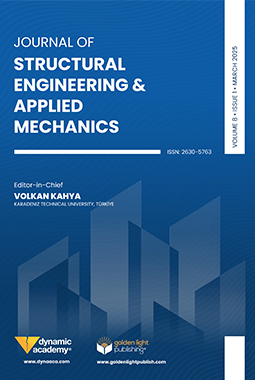ISSN:2630-5763
Journal of Structural Engineering & Applied Mechanics
ARTICLES
Muhammet Ensar Yiğit
Murat Emre Kartal
Fethi Şermet
Emin Hökelekli
Dams are structures that demand a significant amount of concrete, making them costly constructions. Hence, various alternative methods are employed for dam construction, one of which is the use of Roller Compacted Concrete (RCC). This is a case study, which focuses on examining the behavior of RCC dams with and without galleries under seismic excitations, considering the Akçakoca RCC dam in Düzce Province. The seismic ground motion data from the 1999 Düzce earthquake were utilized. The impact of galleries inside the concrete dams was investigated through stress and displacement, considering both empty and full reservoir conditions. The Eulerian-Lagrangian coupled (CEL) approach was employed for two-dimensional fluid finite elements. This study revealed that reservoir water and galleries have a notable influence on the behavior of dams under seismic forces. In cases with reservoirs and galleries, stress and displacement values increased, and critical changes in stresses were observed around gallery areas. Therefore, careful design considerations are essential for dams with galleries under significant seismic forces.
https://doi.org/10.31462/jseam.2024.02084103
Jay Prakash
Ayşe T. Daloğlu
Korhan Özgan
An optimization technique for designing the steel space frame with T-stub semi-rigid connections and interaction between soil and structure is presented in this article. A three-parameter-based elastic foundation model is utilized to investigate soil-structure interactions (SSI). To enable two-way data transfer for all optimization methods, computer software was developed using C# version 17.8.6, which connects to SAP2000-OAPI version 22. Particle swarm optimization (PSO) and teaching-learning-based optimization (TLBO) are employed for optimal designs. These optimization techniques choose profile sections from a list, including 64W discrete sections from the American Institute of Steel Construction (AISC). The Load and Resistance Factor Design-American Institute of Steel Construction (LRFD-AISC) strength constraints, geometric constraints, inter-storey drift constraints, and displacement constraints are considered during optimization. The first phase entails creating optimal designs for two unique steel space frames that consider SSI but do not include T-stub semi-rigid connections. Following that, the same optimization procedures are carried out with T-stub semi-rigid connections. The parameters needed for the foundation model are obtained through soil surface displacements. Utilizing T-stub semi-rigid connections while considering the interaction between the structure and the soil produces increased structural weight.
https://doi.org/10.31462/jseam.2024.02104122
Safa Nayır
Yılmaz Yılmaz
Efflorescence is a common problem in concrete and masonry structures. It occurs when soluble salts in the material are dissolved by water, and then carried to the surface where the water evaporates, leaving behind the salt deposits. In recent years, the construction industry has seen the development of deep learning methods to detect defects and damages such as efflorescence during the service life of structures. These advanced techniques offer more efficient and accurate ways to identify and address issues, improving the overall quality and durability of structures. This study aims to identify efflorescence damage using an innovative deep-learning model. In this scope, 617 different images were taken showing efflorescence defects on concrete and plaster surfaces. A custom dataset was created by labeling the efflorescence regions from the images taken and this dataset was trained using the YOLOv8x model. The accuracy, recall, precision, mAP50, and mAP50-95 performance measures obtained from the YOLOv8x model are 0.962, 0.902,0.991, 0.851, and 0.6334 respectively. According to these performance metrics, efflorescence damage was considerably detected. Finally, the model was tested by taking efflorescence damage images from different concrete and plaster surfaces. The study indicated that detecting efflorescence defects on light-colored surfaces in the model was difficult, with a low detectability rate. Algorithms can be developed to detect efflorescence damage more effectively on light-colored surfaces.
https://doi.org/10.31462/jseam.2024.02123135
Necmettin Güneş
Pınar Bora
Higher first-storey height could cause soft-storey irregularity due to less lateral stiffness, in which the hysteric energy dissipation is localized at the first storey of buildings. In the seismic design codes, two different approaches, based on the drift and lateral stiffness ratios, are used to determine soft-storey irregularity. In this study, four reinforced concrete models with different first-storey to typical-storey height ratios are used to show the first-storey height effects. It is shown that even if the models are regular for soft stories based on the seismic design code limits, the higher first storey considerably decreases the ductility capacity. Also, it is demonstrated that the ductility capacity is highly correlated with the storey height ratio. Although all models meet the design criteria of the Turkish Buildings and Earthquake Code (TBEC-2018), the results of the nonlinear time historey analysis reveal that the first-storey drift ratio considerably increases with the higher first-storey height. Further, the collapse performance of the four models is determined using the FEMA P695 procedure, and the results demonstrate that the collapse probability of the model with the highest first-storey height is over the ASCE 7-22 limit.
https://doi.org/10.31462/jseam.2024.02136147


